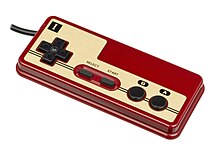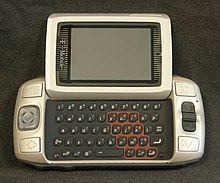D-pad

A D-pad (short for directional pad) is a directional input method developed for video games. The flat plastic top is typically operated by a person's thumb. The plastic rests on four internal switches, each functioning like a push-button. When a person presses a direction on the D-Pad, it will press down one of the switches (for up, right, down, or left) or press down two of the switches (for diagonal directions), offering eight total directions at 45-degree intervals. Most D-Pads contain a hard pivot beneath the center of the plastic. This pivot will prevent the plastic from being pressed onto all four buttons and will cause it to tilt in the direction pressed.
D-pads are found on nearly all modern gamepads and handheld game consoles. Although D-pads offer less flexibility than analog sticks, they offer high accuracy and can be manipulated with minimal movement by the thumb. They require comparatively little maintenance and their minimal profile makes them ideal for portable devices. D-pads have appeared on audiovisual device remote controls, calculators, PDAs, mobile phones, and car stereos. Outside of gaming, some D-pads have a central "OK" or "select" button instead of a pivot point in the center.
History
[edit]
A precursor to the D-pad was the usage of four separate directional buttons. This input method was used in arcade video games such as Gremlin's Blockade (1976)[1] and SNK's Vanguard (1981).[2] Entex's short-lived "Select A Game" cartridge-based handheld system featured left, right, up and down buttons next to a row of action buttons. Similar directional buttons were also used on the Atari Game Brain, the unreleased precursor to the Atari 2600, and on some early dedicated game consoles such as the VideoMaster Star Chess game.[3] The 1981 game Cosmic Hunter on Milton Bradley's handheld Microvision featured four directional buttons around a fifth button in the center, all under a single rubber membrane.[4]

William F. Palisek patented the D-pad for Tiger Electronics in 1979. In Palisek's design, a single piece of plastic rests on a central pivot and four directional switches that provide input and keep the plastic pad resting in a neutral position.[5] Tiger introduced the D-pad on their 1980 handheld game Deluxe Football with Instant Replay and called it the "Playmaker" button in their handheld sports products. Media coverage described it as offering "one-button control".[6][7] The same year, Mattel released the Intellivision with a unique alternative to the joystick, a smooth freely rotating circular pad that registered presses in up to 16 directions.[8][9] Internally, a metal spring holds the Intellivision's control disc centered above sheets of printed mylar.[10]

Nintendo's familiar "cross" design positioned for the left thumb was developed by Ichiro Shirai and used by Gunpei Yokoi for the 1982 handheld adaptation of the Donkey Kong arcade game.[11][12][13] The design was popular on subsequent Game & Watch titles, although Nintendo still utilized separate directional buttons on later titles, including the Super Mario Bros. handheld game. The design was patented and later earned a Technology & Engineering Emmy Award.[14][15]
Initially intended to be a compact control method for Game & Watch handheld games, Nintendo realized that a D-pad would also be appropriate for home consoles and made it the standard directional control for the hugely successful Famicom/Nintendo Entertainment System (first released 1983) under the name "+Control Pad".[16] Part of Nintendo's rationale came from the durability of the D-pad and the expectation that controllers would be left on floors and crushed.[17] All major video game consoles since have had a D-pad of some shape on their controllers, until the Nintendo Switch in 2017, which used the older four-button design on its included Joy-Con controller, allowing each Joy-Con to be used as an individual controller for multiplayer games: the optional Switch Pro Controller, and the handheld-only Nintendo Switch Lite, retain the usual D-pad. To avoid infringing on Nintendo's patent, most controller manufacturers use a cross in a circle shape for the D-pad.[18]

In 1984, the Japanese company Epoch created a handheld game system called the Epoch Game Pocket Computer. It featured a D-pad, but it was not popular for its time and soon faded. Following the release of the Sega Mega Drive in 1988, Sega coined the term "D button" to describe the pad, using the term when describing the controllers for the Sega Genesis in instruction manuals and other literature. Arcade games, however, have largely continued using joysticks.
Modern consoles, beginning with the Nintendo 64, provide both a D-pad and a compact thumb-operated analog stick; depending on the game, one type of control may be more appropriate than the other. In many cases with games that use a thumbstick, the D-pad is used as a set of extra buttons, all four usually centered on a kind of task, such as using items. Even without an analog stick, some software uses the D-pad's 8-directional capabilities to act as eight discrete buttons, not related to direction or on-screen movement at all. Jam Sessions for the Nintendo DS, for example, uses the D-pad to select music chords during play.[19]
Components
[edit]
D-pads vary in design but generally have a:[20][21]
- Circuit board that registers input[22]
- Membrane that is pressed down against the board to complete the circuit[22]
- Hard pivot in the center[23]
- Plastic D-pad "button"[22]
The housing of the controller or other device holds these components together.[20] The central pivot keeps all four directions from being pressed at once and causes the D-pad to tilt into the direction pressed.[20][23] Outside of gaming, D-pads are used for menu navigation and may lack the central pivot. Some remotes instead have a central "select" or "OK" button.[24] With the increased usage of touchscreens, some applications offer virtual D-pads.[21]
On non-gaming equipment
[edit]
D-pads appear on a number of menu-driven devices as a simple navigational tool; though superficially similar to those used for gaming devices, they are not optimized for real-time control and therefore can usually accept input from only one direction at a time. Many, though not all, such designs include a trigger button in the center of the button arrangement, usually labeled "Enter", "OK", or the like. Some older devices do not have D-pads as such, but simple single-axis, up/down or left/right pads. On some remotes, the D-pad can also be used to control a robot using a signal-compatible receiver.
On remote control devices, the buttons on the D-pad function in the same manner as other buttons, and are generally used to navigate on-screen menus. Though initially not common, the quick success of the DVD format led to wide availability of remote designs with D-pads circa 2000, and most current menu-driven consumer electronics devices include some sort of D-pad on the remote (and, occasionally, on the unit itself).
In addition, many small computing and communications devices, particularly PDAs, mobile phones, and GPS receivers, include D-pads not only for menu navigation but as general input devices similar to a joystick or mouse. Less-sophisticated designs similar to those on remote controls appear on some calculators, particularly scientific and graphing calculators, which use the D-pad for cursor control on multi-line screens, as well as input/output recall, menu navigation, and occasionally direct screen access (graphing calculators in particular allow the use of the D-pad to determine values at specific points on a displayed graph). On programmable units, the D-pad can also be mapped directly, allowing it to be used as a gaming or pointer control.
Consoles with D-pads
[edit]
Consoles with separate controllers[edit]
|
Handheld consoles[edit]
|
See also
[edit]Notes
[edit]References
[edit]- ^ Blockade at the Killer List of Videogames
- ^ Matt Barton & Bill Loguidice, The History of Robotron: 2084 - Running Away While Defending Humanoids, Gamasutra
- ^ "Videomaster Star Chess". Ultimate Console Database. Retrieved 2010-08-30.
- ^ Sony's PlayStation Portable and Milton Bradley's Microvision - The PSP and the History of Handheld Video Gaming, Part 2, Niko Silvester, about.com. Accessed on line June 7, 2010.
- ^ United States Expired - Lifetime US4256931A, William F. Palisek, "Multiple Dome Switch Assembly Having Pivotable Common Actuator", published 1981-03-17.
- ^ "Tiger Offers". Toy & Hobby World. Vol. 18. Charleson Publishing Company. 1979. p. 130. Retrieved 29 November 2024.
- ^
- Tiger Deluxe Football with a Playmaker Button (advertisement). Tiger. 1980.
- "Tiger Electronic Toys: Deluxe Football with Instant Replay" (manual). Tiger. 1980.
- ^ Jeffrey, Cal (15 May 2019). "The Most Memorable Game Controllers from the Last 40 Years". TechSpot.
- ^ Wardyga, Brian J. (6 August 2018). "Mattel Intellivision". The Video Games Textbook. CRC Press. ISBN 978-1-351-17234-9.
- ^ Millette, Darryl (29 March 2022). "Repairing the Intellivision: Vintage Gaming Console". SaskaPriest.
- ^ United States US4687200A, Ichiro Shirai, "Multi-Directional Switch", published 1987-08-18.
- ^ Ubachs, Jurian; Kerssenberg, Donovan. "De D-pad is Jarig - Al Veertig Jaar Onmisbaar". Tweakers (in Dutch). Retrieved 29 November 2024.
- ^ McConnel, Samuel (20 October 2016). "Your Move: Yokoi's Creativity Propelled Nintendo". KMUW.
- ^ "Nintendo Wins Emmy For DS And Wii Engineering | Technology | Sky News". News.sky.com. 2008-01-09. Archived from the original on 2012-07-11. Retrieved 2010-08-30.
- ^ Magrino, Tom (2008-01-08). "CES '08: Nintendo wins second Emmy - News at GameSpot". Gamespot.com. Retrieved 2016-04-28.
- ^ "【任天堂「ファミコン」はこうして生まれた】 第7回:業務用機の仕様を家庭用に、LSIの開発から着手" [How the Famicom Was Born – Part 7: Deciding on the Specs]. Nikkei Electronics (in Japanese). Nikkei Business Publications. December 19, 1994. Archived from the original on October 12, 2008. Retrieved 13 April 2021.
- "Deciding on the Specs". GlitterBerri's Game Translations. April 21, 2012. Archived from the original on 2012-04-27.
- ^ Packwood, Lewis (18 July 2023). "40 years of the Nintendo Famicom – the console that changed the games industry". The Guardian.
- ^ "The Next Generation 1996 Lexicon A to Z: Joypad". Next Generation. No. 15. Imagine Media. March 1996. p. 35.
- ^ Abraham, Danielle (2024-08-26). "Best Nintendo Switch Controller 2024". IGN. Retrieved 2024-11-03.
- ^ a b c d Wolf, Mark J. P. (16 August 2012). Encyclopedia of Video Games: The Culture, Technology, and Art of Gaming [2 volumes]. Bloomsbury Publishing USA. p. 281. ISBN 978-0-313-37937-6.
- ^ a b Godbold, Ashley (30 April 2018). Mastering UI Development with Unity: An in-depth guide to developing engaging user interfaces with Unity 5, Unity 2017, and Unity 2018. Packt Publishing Ltd. pp. 424–430. ISBN 978-1-78728-843-0.
- ^ a b c Rouse, Margaret (11 February 2016). "Directional Pad". Techopedia.
- ^ a b Ahmed, Sayem (10 August 2023). "8BitDo M30 review: Retro-looks, modern features". Dexerto.
- ^ "TV navigation". Android Developers. Retrieved 30 November 2024.
- ^ "Tiger Playmaker".
- ^ "Multiple dome switch assembly having pivotable common actuator".
- ^ "Tomy Tron".
- ^ "La GamePark GP2X F-200 enfin disponible pour 120€ - Le Journal du Numérique". Journaldunumerique.com. Archived from the original on 2010-07-30. Retrieved 2010-08-30.
